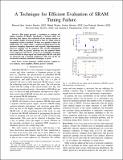| dc.contributor.author | Qazi, Masood | |
| dc.contributor.author | Tikekar, Mehul | |
| dc.contributor.author | Dolecek, Lara | |
| dc.contributor.author | Shah, Devavrat | |
| dc.contributor.author | Chandrakasan, Anantha P. | |
| dc.date.accessioned | 2015-02-06T16:31:23Z | |
| dc.date.available | 2015-02-06T16:31:23Z | |
| dc.date.issued | 2012-09 | |
| dc.date.submitted | 2012-04 | |
| dc.identifier.issn | 1063-8210 | |
| dc.identifier.issn | 1557-9999 | |
| dc.identifier.uri | http://hdl.handle.net/1721.1/93898 | |
| dc.description.abstract | This brief presents a technique to evaluate the timing variation of static random access memory (SRAM). Specifically, a method called loop flattening, which reduces the evaluation of the timing statistics in the complex highly structured circuit to that of a single chain of component circuits, is justified. Then, to very quickly evaluate the timing delay of a single chain, a statistical method based on importance sampling augmented with targeted high-dimensional spherical sampling can be employed. The overall methodology has shown 650× or greater speedup over the nominal Monte Carlo approach with 10.5% accuracy in probability. Examples based on both the large-signal and small-signal SRAM read path are discussed, and a detailed comparison with state-of-the-art accelerated statistical simulation techniques is given. | en_US |
| dc.description.sponsorship | Semiconductor Research Corporation. Focus Center for Circuit and System Solutions (C2S2) | en_US |
| dc.language.iso | en_US | |
| dc.publisher | Institute of Electrical and Electronics Engineers (IEEE) | en_US |
| dc.relation.isversionof | http://dx.doi.org/10.1109/tvlsi.2012.2212254 | en_US |
| dc.rights | Creative Commons Attribution-Noncommercial-Share Alike | en_US |
| dc.rights.uri | http://creativecommons.org/licenses/by-nc-sa/4.0/ | en_US |
| dc.source | Chandrakasan | en_US |
| dc.title | Technique for Efficient Evaluation of SRAM Timing Failure | en_US |
| dc.type | Article | en_US |
| dc.identifier.citation | Qazi, Masood, Mehul Tikekar, Lara Dolecek, Devavrat Shah, and Anantha P. Chandrakasan. “Technique for Efficient Evaluation of SRAM Timing Failure.” IEEE Transactions on Very Large Scale Integration (VLSI) Systems 21, no. 8 (August 2013): 1558–1562. | en_US |
| dc.contributor.department | Massachusetts Institute of Technology. Department of Electrical Engineering and Computer Science | en_US |
| dc.contributor.approver | Chandrakasan, Anantha P. | en_US |
| dc.contributor.mitauthor | Qazi, Masood | en_US |
| dc.contributor.mitauthor | Tikekar, Mehul | en_US |
| dc.contributor.mitauthor | Shah, Devavrat | en_US |
| dc.contributor.mitauthor | Chandrakasan, Anantha P. | en_US |
| dc.relation.journal | IEEE Transactions on Very Large Scale Integration (VLSI) Systems | en_US |
| dc.eprint.version | Author's final manuscript | en_US |
| dc.type.uri | http://purl.org/eprint/type/JournalArticle | en_US |
| eprint.status | http://purl.org/eprint/status/PeerReviewed | en_US |
| dspace.orderedauthors | Qazi, Masood; Tikekar, Mehul; Dolecek, Lara; Shah, Devavrat; Chandrakasan, Anantha P. | en_US |
| dc.identifier.orcid | https://orcid.org/0000-0002-5977-2748 | |
| dc.identifier.orcid | https://orcid.org/0000-0003-1872-1976 | |
| dc.identifier.orcid | https://orcid.org/0000-0003-0737-3259 | |
| mit.license | OPEN_ACCESS_POLICY | en_US |
| mit.metadata.status | Complete | |
